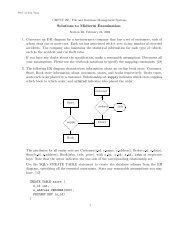CMPUT 340—Introduction to Numerical Methods - Department of ...
CMPUT 340—Introduction to Numerical Methods - Department of ...
CMPUT 340—Introduction to Numerical Methods - Department of ...
Create successful ePaper yourself
Turn your PDF publications into a flip-book with our unique Google optimized e-Paper software.
<strong>CMPUT</strong> <strong>340—Introduction</strong> <strong>to</strong> <strong>Numerical</strong> <strong>Methods</strong><br />
Assignment 4<br />
Winter 2007<br />
<strong>Department</strong> <strong>of</strong> Computing Science<br />
University <strong>of</strong> Alberta<br />
Due: Thursday, April 12 at 23:59:59 local time<br />
Worth: 15% <strong>of</strong> final grade<br />
Instruc<strong>to</strong>r: Dale Schuurmans, Ath409, x2-4806, dale@cs.ualberta.ca<br />
Note: This assignment is <strong>to</strong> be submitted electronically by using the Unix “astep” command.<br />
You need <strong>to</strong> submit the answers <strong>to</strong> all written questions in hard copy <strong>to</strong> the course drop box.<br />
Part 1 (Conversion <strong>to</strong> first order ODEs—2%)<br />
(a) (1%) Exercise 9.1 on Page 416.<br />
(b) (1%) Exercise 9.2 on Page 416.<br />
Part 2 (Stability—3%)<br />
Exercise 9.4 on Page 417.<br />
Part 3 (Euler method—5%)<br />
(a) (2%) Write a Matlab function [yend] = Euler(odefun,t0,tend,y0,stepsize) which<br />
returns the value y end = y(t end ) for the initial value problem specified by the first order<br />
ODE system y ′ = f(t, y) starting at initial vec<strong>to</strong>r y 0 = y(t 0 ) and ending at time t end .<br />
Implement the basic Euler method <strong>to</strong> do this. Note that you need <strong>to</strong> supply a function<br />
odefun such that feval(odefun,t,y) computes the derivatives f(t, y).<br />
(b) (3%) Use your Euler method <strong>to</strong> solve the modified version <strong>of</strong> Computer Problem 9.5<br />
given below.<br />
Part 4 (Simulating dynamical systems 2—5%)<br />
Computer Problem 9.7 on Page 419.<br />
Remember <strong>to</strong> submit all written answers in the course drop box.<br />
1
Appendix: Exercise descriptions from the textbook<br />
Exercise 9.1. (Page 416)<br />
Write each <strong>of</strong> the following ODEs as an equivalent first-order system <strong>of</strong> ODEs:<br />
(a) y ′′ = t + y + y ′ .<br />
(b) y ′′′ = y ′′ + ty.<br />
(c) y ′′′ = y ′′ − 2y ′ + y − t + 1.<br />
Exercise 9.2. (Page 416)<br />
Write each <strong>of</strong> the following ODEs as an equivalent first-order system <strong>of</strong> ODEs:<br />
(a) Van der Pol equation:<br />
(b) Blasius equation:<br />
y ′′ = y ′ (1 − y 2 ) − y.<br />
y ′′′ = −yy ′′ .<br />
(c) New<strong>to</strong>n’s Second Law <strong>of</strong> Motion for the two-body problem:<br />
Exercise 9.4. (Page 417)<br />
y 1 ′′ = −GMy 1 /(y1 2 + y2) 2 3/2 ,<br />
y 2 ′′ = −GMy 2 /(y1 2 + y2) 2 3/2 .<br />
Consider the ODE y ′ = −5y with initial condition y(0) = 1. We will solve this ODE<br />
numerically using a step size <strong>of</strong> h = 0.5.<br />
(a) Are solutions <strong>to</strong> the ODE stable<br />
(b) Is Euler’s method stable for this ODE using this step size<br />
(c) Compute the numerical value for the approximate solution at t = 0.5 given by Euler’s<br />
method.<br />
(d) Is the backward Euler method stable for this ODE using this step size<br />
(e) Compute the numerical value for the approximate solution at t = 0.5 given by the<br />
backward Euler method.<br />
2
Modified Computer Problem 9.5. (Adapted from Page 419)<br />
The following system <strong>of</strong> ODEs models nonlinear chemical reactions<br />
y ′ 1 = −αy 1 + βy 2 y 3 ,<br />
y ′ 2 = αy 1 − βy 2 y 3 − γy 2 2,<br />
y ′ 3 = γy 2 2,<br />
where α = 4 × 10 −2 , β = 10 4 , and γ = 3 × 10 7 . Starting with initial conditions y 1 (0) = 1<br />
and y 2 (0) = y 3 (0) = 0, integrate this ODE from t = 0 <strong>to</strong> t = 3. Plot each <strong>of</strong> y 1 , y 2 , and<br />
y 3 as a function <strong>of</strong> t, and also plot each <strong>of</strong> the trajec<strong>to</strong>ries (y 1 (t), y 2 (t)), (y 1 (t), y 3 (t)), and<br />
(y 2 (t), y 3 (t)) as a function <strong>of</strong> t, each on a separate plot. Try perturbing the initial values by<br />
a tiny amount and see how much difference this makes in the final value <strong>of</strong> y(3).<br />
(Note that you will have <strong>to</strong> experiment with the stepsize parameter in Euler <strong>to</strong> balance<br />
the run time and accuracy for solving this problem.)<br />
3
Computer Problem 9.7. (Page 419)<br />
An important problem in classical mechanics is <strong>to</strong> determine the motion <strong>of</strong> two bodies under<br />
mutual gravitational attraction. Suppose that a body <strong>of</strong> mass m is orbiting a second body<br />
<strong>of</strong> much larger mass M, such as the earth orbiting the sun. From New<strong>to</strong>n’s laws <strong>of</strong> motion<br />
and gravitation, the orbital trajec<strong>to</strong>ry (x(t), y(t)) is described by the system <strong>of</strong> second-order<br />
ODEs<br />
x ′′ = −GMx/r 3 ,<br />
y ′′ = −GMy/r 3 ,<br />
where G is the gravitational constant and r = (x 2 + y 2 ) 1/2 is the distance <strong>of</strong> the orbiting<br />
body from the center <strong>of</strong> mass <strong>of</strong> the two bodies. For this exercise, we choose units such that<br />
GM = 1.<br />
(a) Use a library routine <strong>to</strong> solve this system <strong>of</strong> ODEs with the initial conditions<br />
x(0) = 1 − e, y(0) = 0,<br />
x ′ (0) = 0,<br />
( ) 1 + e 1/2<br />
y ′ (0) =<br />
,<br />
1 − e<br />
where e is the eccentricity <strong>of</strong> the resulting elliptical orbit, which has period 2π. Try<br />
the values e = 0 (which should give a circular orbit), e = 0.5, and e = 0.9. For each<br />
case, solve the ODE for at least one period and obtain output at enough intermediate<br />
points <strong>to</strong> draw a smooth plot <strong>of</strong> the orbital trajec<strong>to</strong>ry. Make separate plots <strong>of</strong> x versus<br />
t, y versus t, and y versus x. Experiment with different error <strong>to</strong>lerances <strong>to</strong> see how<br />
they affect the cost <strong>of</strong> the integration and how close the orbit comes <strong>to</strong> being closed.<br />
If you trace the trajec<strong>to</strong>ry through several periods, does the orbit tend <strong>to</strong> wander or<br />
remain steady<br />
(b) Check your numerical solutions in part a <strong>to</strong> see how well they conserve the following<br />
quantities, which should remain constant:<br />
Conservation <strong>of</strong> energy:<br />
(x ′ ) 2 + (y ′ ) 2<br />
2<br />
Conservation <strong>of</strong> angular momentum:<br />
− 1 r ,<br />
xy ′ − yx ′ .<br />
(Note: you can use any <strong>of</strong> the ODE solvers in “help funfun” that you wish <strong>to</strong> solve this<br />
question, but please document your choice.)<br />
4




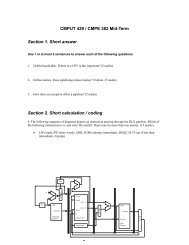

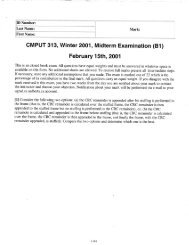
![CMPUT 313 Final Exam [Harms] April 26, 2000 g L (Ilosed Book](https://img.yumpu.com/45617471/1/190x245/cmput-313-final-exam-harms-april-26-2000-g-l-ilosed-book.jpg?quality=85)
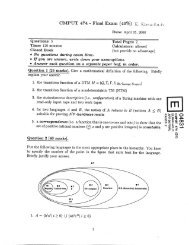
![CMPUT 379 Midterm Exam [Harms]](https://img.yumpu.com/44750568/1/190x245/cmput-379-midterm-exam-harms.jpg?quality=85)



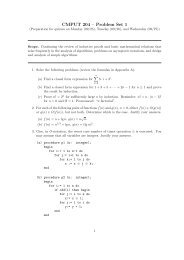

![CMPUT 272 Midterm [B2 -- Harms]](https://img.yumpu.com/36401258/1/190x245/cmput-272-midterm-b2-harms.jpg?quality=85)
